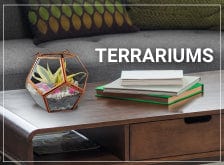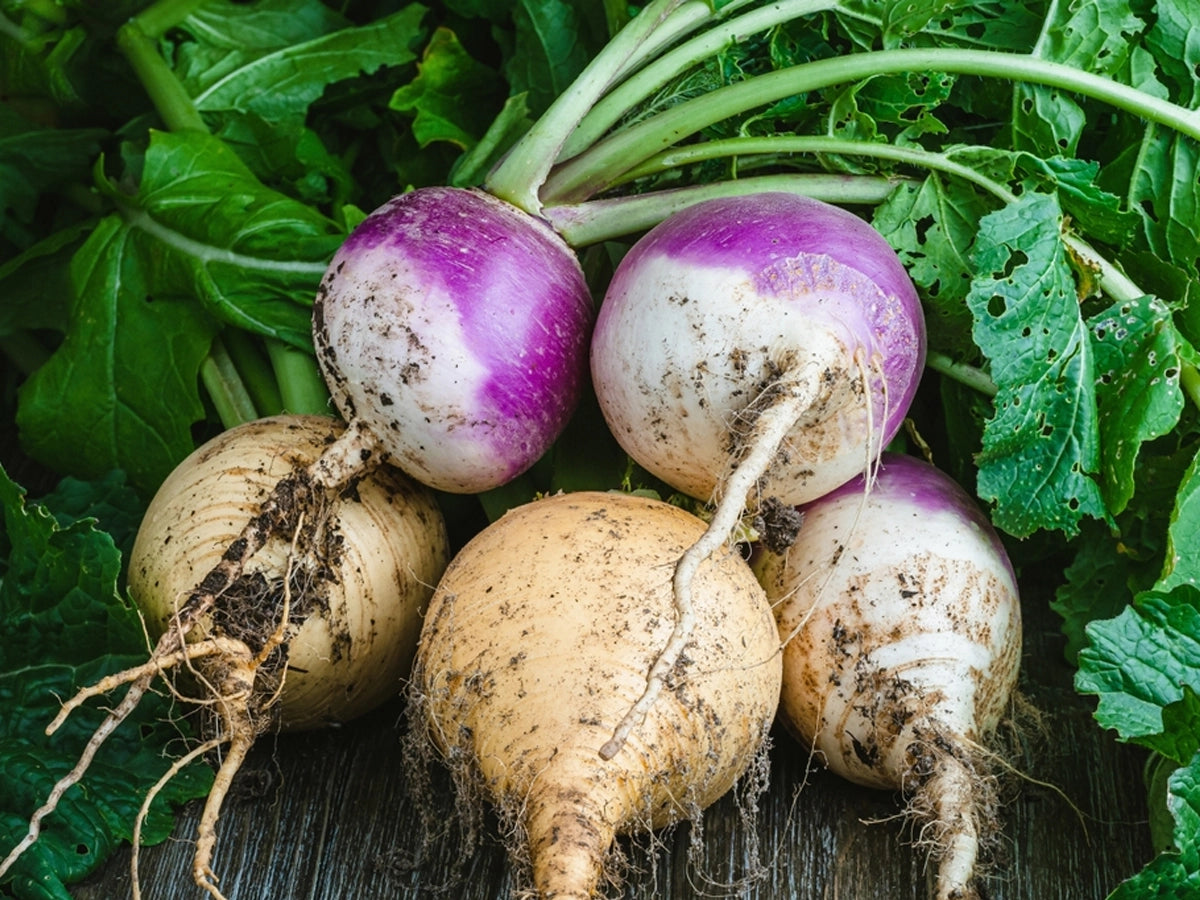How to Grow
Grow shalgam/turnip easily with our growing instructions and care guide
Imagine a family of achievers with a professor, a doctor, a lawyer, and an award-winning film-maker, and then they have a cousin who is a college dropout and works with an NGO.
Turnip or shalgam, among celebrities such as cauliflower, cabbage, kale, arugula, or broccoli, feel like that cousin—underrated and underappreciated!
The nutritional value of shalgam may persuade people to adore it more.
What’s so special about turnips?
Well, turnips or shalgam are rich in vitamins and minerals like potassium, calcium, vitamin C, etc. Plus, they are easy to grow at home, which makes them a perfect plant even for beginners.
In this blog, we will go over Shalgam in depth and cover the following topics:
- How to grow shalgam at home easily?
- Care instructions for shalgam cultivation at home
- Benefits of including shalgam in your diet
So, let’s dive into the cruciferous world of Shalgam.
How to grow shalgam at home easily?
Turnip or shalgam are low-maintenance plants that require minimal care. So, even a beginner can think of planting it at home. The plant gets ready for harvest within five to ten weeks. The easy step-by-step process of growing shalgam at home is given below: -
Growing shalgam – outdoor home garden
Ideal time
The ideal time to sow turnips would be in the spring or fall. Shalgam thrives in cooler temperatures, which is why you would see them regularly in the vegetable market during the winter season. Shalgam is harvested twice a year, once in the spring and once in the fall. For spring turnips, you should sow the seeds 3 weeks before peak winter arrives, and for fall turnips, you should sow the seeds in mid-summer.
Location in your garden
Find an area in your garden that gets at least 6 hours of sunlight daily for growing shalgam. Also, the selected spot in your garden should have naturally loose soil with good drainage. Turnips grow best in soil with a pH of 6.5, so you have to check your soil pH first.
Prepare soil
In this stage, you have to check the quality of the soil and make it favorable for the growth of shalgam. Loosen the soil with a shovel to a depth of 12–15 inches. Now mix compost for the top 2-4 inches of the soil. You may also add mature manure to this compost, which will enhance the fertility of the soil.
Sow seeds
Bring shalgam seeds from a local store or order them online and evenly distribute them on your garden plot. After spreading the seeds, cover them with soil for 1/4th inch for spring season turnips and ½ inch for fall-season turnips. You can also spread the shalgam seeds in rows spaced 12 to 18 inches apart.
Germination
Seeds of shalgam will germinate in a week or two. Meanwhile, keep watering the plant. Just keep the top soil moist and stay away from overwatering.
Saving the stronger plants
As the seedlings reach 4 inches in height, you have to pull out the weakest ones so that the stronger ones grow. If you have planted turnips for their greens, then you don’t have to pull out the thin ones.
Mulching
When the plants reach 5 inches in height, add 2 inches of mulch around the greens. This mulching will get you better growth and a great flavor of turnips.
Harvest
As soon as the shalgam greens are big enough to pick, you can harvest them. Typically, this occurs when the leaves are 4 to 6 inches tall (10 to 15 cm). When turnips reach maturity, pluck out the roots. After planting the seeds, this takes at least 5 to 10 weeks.
By gently brushing away soil from the top of one plant to reveal the root below, you can measure the root's size. The majority of the plants will probably be ready to harvest if that one plant appears to be.
Turnips can be harvested at almost any size. The majority of people, however, prefer to pick turnips when the roots are between 1 and 3 inches (2.5 and 7.5 cm) in diameter since small turnips are soft and typically tend to be slightly sweeter than bigger ones.
Growing shalgam – indoor home garden
Pot for shalgam
- Because shalgam is a root vegetable, choose a pot or container that is at least 12 inches wide. But in case you want to grow shalgam only for the green leaves, then a 6 inches width pot would also work just fine.
- Again, remember that the size of the pot will depend on the type of turnip you want to grow. Those varieties of turnips that are bigger will require a bigger container for proper growth.
Coffee filter
Now that you have finalized the container, place a coffee filter at the bottom so that the soil doesn’t leach out of the drainage holes while you are watering.
Potting soil
Fill in the pot with potting soil. Mix this soil with compost and perlite to provide nourishment to the plant and good drainage.
Sow seeds
Place the shalgam seeds 4–6 inches apart if you intend to use them as a root vegetable
Grow under the sun
Place this container in a sunny location and check to see if it needs water on a daily basis. Turnip plants grown in containers require more water than those grown directly in garden soil. So, it is advised to water the plants until the water drips out of the drainage holes.
Thinning
As the plant reaches 4 inches in height, you have to thin it by removing the weaker ones
Harvest
When the plant becomes 6 inches tall, it is ready for harvest. Cut the leaves and leave the roots for further production. Harvest the shalgam when the roots have reached 2–3 inches in diameter.
Care instructions for shalgam cultivation at home
Taking care of shalgam plants is easy. Follow the instructions given below: -
Sunlight
Turnips prefer full sunlight for at least 6 hours. But partial shades also work for them.
Location
Any area in your home where shalgam can receive at least 6 hours of direct sunlight will be great for placing the plant.
Soil
The shalgam plants require a soil that is slightly acidic. The pH should be between 6.0 and 6.5. So, choose a well-drained, moderately deep loam—fertile soil—for growing shalgam.
Temperature
The soil temperature should be 4 degrees for faster germination. Then a temperature between 10 and 21 degrees Celsius is ideal for the growth of the plant.
Water
Just an inch of water per week is sufficient for the growth of this root vegetable plant. But don’t let the topsoil dry, and water regularly for a nice and flavorful production.
Fertilizer
Turnips don’t require fertilizer, but you can apply some organic fertilizer before planting the seeds, like compost or manure.
Diseases
There can be an aphid or flea beetle infestation on shalgam greens. Use a hose to spray the beetles away in that situation. If turnip leaves have been overrun by aphids, pinch or eliminate that foliage to prevent the aphids from spreading. Turnips can be safeguarded against root maggots, despite the fact that they occasionally succumb to them, by spreading diatomaceous earth around the plants.
Benefits of including shalgam in your diet
The green leaves of shalgam are loaded with health benefits. One cup of raw shalgam leaves has 6830 IU or International Units of Vitamin A and 33 mg of Vitamin C. The nutritional value of one cup of raw shalgam is given below: -
|
Calories |
36.4 |
|
Calcium |
39mg |
|
Carbohydrate |
8.36g |
|
Fiber |
2.34g |
|
Fat |
0.13g |
|
Folate |
19.5mcg |
|
Iron |
0.39mg |
|
Magnesium |
14.3mg |
|
Protein |
1.17g |
|
Phosphorus |
35.1mg |
|
Sodium |
87.1mg |
|
Vitamin C |
27.3mg |
|
Vitamin K |
0.13mg |
|
Zinc |
0.35mg |
This root vegetable can thus provide you with the following health benefits: -
Reduced risk of cancer
According to medicalnewstoday.com, the risk of cancer is decreased with a high consumption of cruciferous vegetables like cauliflower, cabbage, and turnips. According to a 2015 study, sulforaphane, which is frequently found in cruciferous vegetables like shalgam, may impair the activity of the enzyme histone deacetylase, which is involved in the growth of cancer cells. You can find that study at https://www.ncbi.nlm.nih.gov/pmc/articles/PMC4432495/.
Lowering blood pressure
A 2013 study published in the British Journal of Clinical Pharmacology discovered that nitrate-rich foods like shalgam or turnips may improve blood vessel health. That includes lowering blood pressure and preventing the blood platelets from sticking to one another.
Also, don’t forget the potassium content in shalgam. This also aids in blood pressure reduction.How? That’s because potassium is a vasodilator, which eases the pressure on blood vessels and allows blood to flow more freely through arteries. This in turn helps to ward off different cardiovascular problems, including hypertension. Moreover, turnips are anti-inflammatory, and that’s how they can help curb any inflammation of the arteries.
Aids in digestion
Turnip, or shalgam, is high in fiber and that’s why it is good for our digestive system. They help in increasing the formation of digestive juice and enzymes, which in turn help in the easy digestion of complex proteins and carbohydrates. Including turnips in your diet may help you with other digestive issues like indigestion, constipation, flatulence, a stomach infection, etc. But consult a doctor first if you have any digestive disorders.
Effective for weight loss
Low in calories & high in fiber—that’s a perfect combination for weight-loss diets. Shalgam is thus the ideal food for those looking to shed a few pounds. Dietary fiber keeps one full for a longer time, reducing the tendency to overeat. Turnips have a low calorie count, and thus they can be eaten frequently without any worries, contributing to weight loss.
Good for bones
Calcium, phosphorus, and magnesium are important minerals that are required for healthy bones. Turnip is a rich source of all these minerals, so consuming this vegetable would increase bone density. Experts also say that if turnips are consumed on a regular basis, they can help prevent osteoporosis and other bone-related diseases. Moreover, shalgam is a rich source of vitamin C, which helps the body absorb more calcium, protecting bones from oxidative damage brought on by free radicals.
Great food for skin
Vitamin C enhances the radiance of the skin, and turnips are a great source of that. This vitamin C is a strong antioxidant that protects our skin from the risks of macular degeneration. Regular consumption of shalgam can aid in the prevention of aging, the removal of wrinkles, and the elimination of dark spots.
Turnips are eaten raw in salads and cooked in a variety of ways. They are delicious in curries or soups and, as mentioned above, have many therapeutic effects. Any vegetable that you can grow in your yard is always a pleasure to have on your plate, isn’t it? That way, you can steer clear of chemical fertilizers often used in mass production. Shalgam is an easy plant to grow, so you can grow it in your home and reap its advantages.
FAQ’s related to shalgam
Is shalgam good for health?
Yes, shalgam is a healthy vegetable. It is a rich source of vitamin C, potassium, folate, phosphorus, fiber, and many other nutrients.
How do turnips or shalgam taste?
Shalgam, or turnip, is slightly spicy if eaten in raw form. When cooked, the taste becomes sweet, earthy, and nutty.
Which is the best way to consume turnips?
You can consume turnips in raw, boiled, baked, or cooked form. Try to use less oil or spices to retain the goodness of this healthy vegetable.
Is shalgam a superfood?
Shalgam is rich in dietary fiber, vitamin C, folate, potassium, phosphorus, calcium, manganese, and vitamin B6. With so many essential vitamins and minerals, shalgam is surely a superfood.
Are turnips difficult to grow?
Turnips are easy to grow. They are low-maintenance plants that grow quickly. Just provide 6 hours of sunlight, one inch of water per week, slightly acidic soil, and a temperature between 10 and 21 degrees Celsius to turnip plants, and they will grow without any fuss.
How long does a turnip or shalgam take to grow?
After sowing, turnips or shalgam will take 5 to 10 weeks to grow or get ready for harvest.



